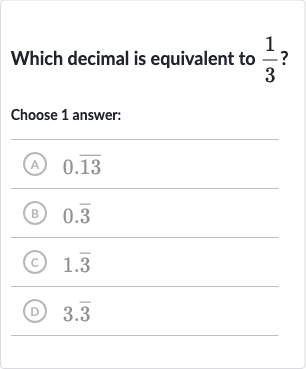Full solution
Q. Which decimal is equivalent to ?Choose answer:(A) (B) (C) (D)
- Understand repeating decimals: Understand the concept of repeating decimals. A repeating decimal is a decimal number that has a digit or a group of digits that repeat infinitely. The bar notation (like ) indicates that the digit under the bar repeats without end.
- Convert fraction to decimal: Convert the fraction to a decimal.To convert a fraction to a decimal, we divide the numerator by the denominator. So we divide by .
- Perform division: Perform the division .When we divide by , we get , with the repeating infinitely.
- Express using bar notation: Express the repeating decimal using bar notation.Since the digit repeats infinitely, we use the bar notation over the to indicate this repetition. Therefore, is equivalent to .
More problems from Identify equivalent linear expressions
QuestionGet tutor help
QuestionGet tutor help
QuestionGet tutor help
QuestionGet tutor help
QuestionGet tutor help

